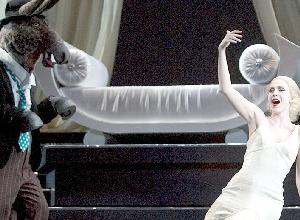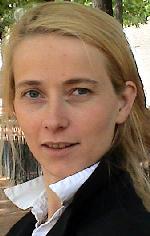SEARCH CurtainUp
TKTS
LETTERS TO EDITOR
REVIEWS
FEATURES
LISTINGS
Broadway
Off-Broadway
DC
NEWS (Etcetera)
BOOKS and CDs
OTHER PLACES
Berkshires
DC (Washington)
London
Los Angeles
QUOTES
FILM
LINKS
MISCELLANEOUS
Free Updates
Masthead
NYC Weather
 Berkshires
Berkshires Summer 2004 Music and Dance Diary
By Elyse Sommer
Additional entries will be posted, with additions placed at the top.
August 30, 2004. Jacob's Pillow is not usually a place ford dancers in tutus and tiaras. But that's exactly what Pillow audiences got in the Festival's last of the season offering from the Boston Ballet by way of George Ballanchine's . . . .. The audience at the matinee I attended seemed to eat up this easy to look at quite traditional program. The strongest dances included : Sharon Eyal's Love for Batsheva and Mats Ek's Solo for Two for Les Grands Ballets Canadiens de Montreal. My favorite -- Jorma Elo's cutesy-titled Plan to B. There was nothing cutesy about this work choreographed to music by Heinrich von Biber. Its leaps and pirouettes, full of oddly affecting hand movements, made for a powerful .... minutes that flew by. Drink to Me Only With Thine Eyes was Mark Morris's rather sugary contribution which had white clad dancers flit about like so many cooing, courting birds. And yes, there was a George Balanchine -- Duo Concertant accompanied by a live piano and violin and Who Cares? choreographed to George Gershwin melodies. For the romantically inclined there was a lovely pas de deux for Lady of the Camellias. The mix of something old and something new -- like Plan to B -- . . . At 2 hours, 20 minutes with intermissions I found the new that one has come to expect at Jacob's Pillow moving along a lot faster and more vibrantly than the more traditional. It's hard to believe that the season is almost over.
August 24, 2004. Boston Pops concerts tend to be win-win-win propositions. Though I'm not as enamored of these crowd pleasing evenings as those who flock to them regularly, Kristin Chenoweth's debut at the shed was the equivalent of a command performance for someone whose beat is the theater. The petite blonde with the big as an ocean smile and talent to match did not disappoint. She's as charming and accomplished a concert performer as she is a Broadway musical star. Though conductor Keith Lockhart led the Pops in a number of orchestral arrangements from well-known musical, he wisely yielded the spotlight to his guest.
The evening showcased all of Chenoweth's considerable assets. Chief among these is a remarkable split-personality soprano that's equally at home delivering a sultry ballad like Jerome Kern's "Bill " or thrillingly operatic in the full of trills "Glitter and Be Gay." Being a gifted comedienne as well as singer, she most amusingly demonstrated how her opera voice (she's classically trained) at times intruded when she was in her show biz mode. To add to the evening's fun, Chenoweth several times kicked up her heels with dancers David Elder and Sean Martin-Hingston and had a table of props to help her truly glitter and be gay during the Candide number which was the evening's highlight.
Now that she's won the hearts of Tanglewood audiences, let's hope she will return again -- perhaps for a full concert version of Candide in the more intimate Ozawa Hall where she wouldn't need a hand and a head mike.
Check out CurtainUp's review of Ms. Chenoweth's Tony-winning performances as Sally in You're a Good Man, Charlie Brown and her most recent Broadway role of Glinda, the good witch in Wicked.

Seth Rogovoy
|
Being live rather than sealed between covers of a book, Rockin' the Shtetl enabled Rogovoy to spice his talk with visuals and musical excerpts and make it doubly meaningful by spending more time on discussing Woody Guthrie's connection to klezmer through his son Arlo Guthrie's grandmother Aliza Greenblatt, a Yiddish poet whose words were used as the lyrics for a song called "Fisherlid." The band's use of drums as well as more common klezmer instruments to make their music rock as well as sing and wail in traditional klezmer fashion, beautifully brought home Rogovoy's point about the revitalization of this music which honors tradition but also moves it forward.
Timothy Quigley's drumming did indeed make the music rock, but there was also plenty of the traditional heartstring touching groaning and laughing. Golem's leader Annette Ezekiel gracefully did triple duty as accordionist, singer and narrator. Alicia Jo Rabins made her expert fiddling seem as easy as brushing her teeth. Rounding out the energetic sextet were trombonist Curtis Hasselbring and bassist Taylor Bergren-Chrisman.
Judging from the enthusiasm of the overflow audience at the afternoon performance I attended, everybody who was able to snag a ticket had a finger and foot-tapping good time; that included the very young as well as the young at heart. Here's hoping the area's own pied piper of klezmer and the Golem band repeat this entertaining and informative program next summer. In the meantime, you can brush up on your klezmertize with The Essential Klezmer which is chockablock with fascinating stories and facts such as klezmer's etymological origin as a portmanteau word that combines the Hebrew kley or vessel and zemer.For price and ordering information go here.
August 9, 2004. According to Tanglewood's program for the season the crowds flocking to the Sunday and Monday night concert at Ozawa Hall would not have been wrong to expect musical theater star Brian Stokes Mitchell to be the evening's main event. As it turned out, the featured jazz quintet, especially the terrific trumpeter Carl Saunders and drummer Steve Houghton stole the show.
I've been a fan of Stokes Mitchell's rich baritone and acting ever since he portrayed Coalhouse Walker in Ragtime. Unfortunately, while he may see himself as much as a jazz singer as a musical theater actor-singer notable for his rich delivery of rousing ballads, this program both underused and misused him. Unlike Dianne Reeves, who shared the stage with him and whose career is built on jazz, Stokes Mitchell seemed uncomfortable and didn't have enough to do to really settle into this, for him, new style.
The second and highlighted part of the evening, John Williams' jazz arrangement of the classic Lerner and Loewe score, had one nice Stokes Mitchell-Reeves duet ("The Rain In Spain") but proved to be one of those musical conceits that only someone as popular and successful and Williams could get away with. Williams mentioned that Lerner and Loewe forgave him for it, though I'm not sure they should have. For sure, it was not a good choice for the wonderful Stokes Mitchell's jazz concert debut.
Here's hoping that Boston Pops impresario Keith Lockhart will give Kristin Chenoweth, another musical theater star making her Tanglewood debut, a true starring role on August 23rd. The petite, chronically adorable star has a soprano voice of operatic proportions.

Tytania swoons in Tanglewood's production of Britten's Midsummer Night's Dream.
|
Though the music can be something of an acquired taste, Britten and collaborator Peter Pears managed to pare down Shakespeare's text (Under 3 hours, with 2 intermissions) and yet stay true to it. Most interestingly he developed music unique for each of the various groups of characters. Under David Kneuss's direction and Stefan Asbury, conducting, the Tanglewood Music Center's Vocal Fellows and Orchestra couldn't have been better. John Michael Deegan's and Sarah G. Conley visual concept for the 1940ish style production was breathtakingly beautiful and inventive, without being fussy. The forest through which the lovers, fairies and mechanicals roved were evoked by a series of steps, and sheer white curtains moved gracefully by an enchanting group of tuxedo-clad fairies, members of PALS (Performing Arts at Lincoln School) children's chorus in Brookline, MA.
The predominantly black and white motif at times made you think of one of those grand old movie musicals of the 40s, a look underscored by a sequin gowned Tytania (Anne-Carolyn Bird) and the very blonde Oberon (Jose Lemos) and Puck (Kyle Barry). Their voices were as splendid as their looks, with Jose Lemos's counter tenor especially impressive. The story is so familiar and the voices generally so clear that the super titles were almost superfluous. The three groups of forest wanderers provide plenty of opportunities for the superb young singers. The sequence when Puck leads the lovers (Erika Rauer as Helena, Lex Ferrill as Hippolyta, Kathryn Leemhuis as Hernia and Randy Bills as Lysander) up and down is the stuff of magic, as is the sexy shadow play scene with the donkey-headed Bottom (Charlie Temkey).
This is indeed a dreamscape to remember. Having on the previous day seen a less frequently staged and much shorter opera, Leonard Bernstein's Trouble In Tahiti (review), I wish Tanglewood would schedule its own revival of this genre crossing work by one of its most legendary conductor-composers. This chamber opera requires no orchestra pit and could easily be staged at Ozawa Hall -- ideally during the Contemporary Music Festival.
July 18, 2004. A sense of peace always envelops one upon entering Ozawa Hall, especially so on a sunny afternoon. It was just such an aftgernoon last Saturday when the Boston University Tanglewood Institute orchestra, better known as the BUTIs, performed Beethoven's Leonore Overture No. #3 in C Major, Op. 72b (did you know that Beethoven composed two Leonore overtures?) and Rachmaninov's Symphony No. 2 in E minor, Op.27. Frederico Corteso, the music director of the Greater Boston Youth Orchestra and erstwhile TMC conducting fellow ably led the energetic musicians through the two pieces which were separated by a brief pause rather than an intermission. I couldn't think of a better way to spend a summer afternoon! In case you missed the July 17th concert, be sure to mark your calendar for July 31st at 2:30, when the young musicians return with the charismatic conductor David Hoose for works by Vaughan Williams and Stravinsky.
While I wasn't able to attend Friday night's Shed concert with Midori, I hear that the violinist much beloved by Tanglewood audiences was better than ever. I did, however, hear a less well known young violinist, TMC fellow Carrie Kennedy, give a thrilling solo performance at Monday's second TMC concert. While I was disappointed that the two conducting fellows from the previous concert were not on hand, Ms. Kennedy's playing as part of Strauss's A Hero's Life brought its own rewards. Conducgtor Rafael Fruebeck De Burgos elicited first-rate playing both for the Strauss and the two Haydn symphonies for string and wind instruments that initiated the evening. The second Haydn featured another fine solo by that segment's principal violinist, Amanda Chamberlain. Star quality music isn't always attached to the name of a star!
July 18, 2004. The Lar Lubovitch and this writer have something in common. Our visits oo the Jacob's Pillow Dance Festival are too few and far between. I do get to the Pillow considerably more often than Mr. Lubovitch and his dancers who made their last appearance in Beckett twenty years ago.
Having missed the premiere of his much talked about Men's Stories when it premiered at the Orensanz Center for the Arts in New York, I wasn't going to miss the opportunity to catch up with it during its July 14th to 18th run at the Ted Shawn Theatre. I'm glad I did.
The program also featured the 2002 ... smile with my heart, created for the American Ballet Theatre to commemorate composer Richard Rodgers' centenary. Though beautifully danced, this segment was more or less a curtain raiser for the longer and more complex Men's Stories, subtitled A Concerto in Ruin. As Pillow executive director Ella Baff pointed out in her customary introductory remarks, a ballet for men only is a particularly fitting way to reintroduce Lubovitch to this audience as it was the Ted Shawn who pioneered the concept of male oriented ballet.
The nine dancers spin these stories with radiant energy, each one putting his own stamp of what seems to be a variation of the male persona that evolves from parental advice, societal expectation and the macho culture. The " stories" begin in a fog-like atmosphere created lighting designer Clifton Taylor and a formality suggested by Ann Hould-Ward's black velvet Edwardian coats. Soon (and probably not too soon for the comfort of the dancers!) the jackets are shed to reveal silvery silk shirts and eventually still lighter sheer tops. The multiple solo, dual and group stories end as they began, with the men back in their velvet coats-- along with a surprise guest, a child-sized puppet dressed to match the dancers. If this back-to-the-beginning end and the puppet seem a bit too self-consciously schematic, no matter. The dancing in between is gorgeous. Superb as these dancers are, what makes this close to an hour piece riveting is Scott Marshall's fabulous fusion of background noises, voices and music with Beethoven's Emperor and Piano Concerto #3.
Though the Lubovitch Company will have departed by the time you read this, there's a feast of interesting programming still to be enjoyed -- including the wonderful FREE Inside/Out performances. For full details about these and other events, check their website at www.jacobspillow.org

Hèlène Bouchez
|
Mr. Wolfe got things off to a fine start with his assured conducting of Mendelssohn's Overture to Ruy Blas w composed as a prelude to a production of a Victor Hugo play. With women conductors still all too few and far between, Ms. Bouchez supplied the biggest buzz of enthusiasm. With her long blonde hair, stylish red-lined knee-length coat and dashing shirt and pants, she's stunning to look at -- but this isn't a case of style over substance. Ms. Bouchez's conducting of Kodály's opera Háry Jáno was authoritative and marvelously expressive. A friend who sat in the balcony facing the conductor told me she seemed to be talking to and embracing the players through each movement.
Mr. Masur's segment of the evening included the Prelude and "Liebestod" from Tristam and Isolde, with Annalena Persson's soprano powerful enough to rise above the Wagnerian sturm and drang. The evening ended phony No. #3, known as the Scottish.
No matter who was at the podium, the TMC fellows were superb. Their next concert, on July 19th will feature music of Haydn and Strauss and the conductor Rafael Fruhbeck de Burgos. And I hope a return engagement of Joseph Wolfe and Hèlène Bouchez.

Wynton Marsalis taking a bow when the piece was done in Boston last December.
(Photo: Stu Rossner )
|
To underscore the genre crossing, all-audience appeal of this piece, Kurt Masur was at the podium. The septuagenarian, though associated with classical music of a more traditional stripe, commissioned the work and saw it through its birth pangs. As Masur several times just stood back, his shoulders shaking with the jazz, blues and gospel rhythms of the piece, so Marsalis --whose trumpet playing can make listeners feel as if they are in the presence of a horn blowing angel-- shared the solos with the horn players of his band. Unlike traditional symphonies where applause between movements is considered bad form, the audience could not be denied their between-movement applause. The twelfth and final movement, from which this enticing composition takes its title, did indeed have the audience rising to give Masur and Marsalis and the musicians a rousing bravo.
With Friday nights usually not sold out because many weekenders come up too late to attend, it would have been nice if the powers that be at Tanglewood had made more of an effort to bring in more young people who are a big potential audience for music like this. It is one thing to present music to reach out to audiences of all colors and income -- but it takes a commitment to an active outreach program to turn the shed into a true melting pot and thus give symphonic jazz a chance to succeed
The rest of the weekend was also devoted to single composers -- Ravel on Saturday and that ever-popular Wunderkind, Mozart, on Sunday. With all the publicity about Leon Fleisher regaining use of his long crippled right hand, it was something of a letdown to mark his return to Tanglewood with Ravel's Concerto for Left hand, even though he he performed it gracefully with feeling. Emmanuel Axe lent his usual fluency to Mozart's Piano Concert No. 27 in B-flat, K.595.

Kristin Chenoweth
|

Brian Stokes Mitchell
|
July 6, 2004. No matter who' s at the podium or what's on the program, the amazing thing about the first concert by the Tanglewood Music Center Orchestra of each season is this: Here's a stage filled with young musicians who until now never played together before. Yet, here they are making music together, and doing so with nary a missed beat.
Heavy thunderstorms and warnings of more "music" from Mother Nature made this opening event not quite the usual complete sell out. The fact that the first half of the program was devoted to the 12-tone method pioneered by Arnold Schoenberg, may also may have accounted for the somewhat thinner (but still substantial) crowd. That said, the orchestra under the leadership of German guest maestro Ingo Metzmacher performed both the 12-tone introductory piece by Luigi Dallapiccola and Schoenberg's own "Five Pieces for Orchestra, Opus 16" with enough verve to hold the attention of even those who prefer their classical music to be more melodic, a majority despite Tanglewood's persistent championship of contemporary classical music -- when you consider that Schoenberg has been dead for more than half a century, calling his music system "new" is something of an oxymoron.
At any rate, the "traditionalists" were rewarded with a rousing rendition of Berliotz's passionate "Symphonie Fantastique" Ever since this piece inspired puppeteer Basil Twist to create an amazing spectacle of floating and swirling "characters" of geometric shapes and anthropomorphic in a huge tank of water, whenever I hear this piece I also have vision of Twist's long-running and surprising off-Broadway hit also named "Symphonie Fantastique".*
If you missed seeing some of the TMC conducting fellows on stage, not to worry. At the next TMC concert (July 12th), Maestro Kurt Masur will share the stage with TMC fellows Joseph Wolfe and Helene Bouchez. Tickets for this Mendelssohn, Kodaly and Wagner program are likely to be scarce as the perennial hen's teeth. Mark your calendar not just for this but another outstanding student series-- the Saturday afternoon concerts by the younger students of the Boston University Tanglewood Institute. The dates for July are the 17th and the 31st, also at Ozawa Hall.
* Just as I posted the above, I received a press release announcing that Basil Twist's Symphonie Fantistique and the water tank -- expanded from 500 to 1,000 gallons --will return to New York as one of the inaugural productions at the new Dodger Stages, a mutliple theater complex on west 50th Street, with previews beginning August 31st prior to the official press opening September 16th.



Retold by Tina Packer of Shakespeare & Co.
Click image to buy.
Our Review

Berkshire Hikes &
The Berkshire Book
Great Places to Eat, Shop, Stay
Sheffield Pottery
In Lee:
Morgan House Inn & Restaurant
In Lenox:
Andrew De Vries Sculptures
In Williamstown
Pappa Charlie's Deli
Thai Garden
Listing information: esommer@curtainup.com

6,500 Comparative Phrases including 800 Shakespearean Metaphors by CurtainUp's editor.
Click image to buy.
Go here for details and larger image.

